Menus
- The most beautiful motorcycles in the world?
- Is the V-twin cylinder the ideal?
- Allow as little bending force as possible into the braid
- Camshafts come from the Australian Ducati tuner Vee Two
- Swiss mountain champion in 1968 was called Fritz Walter Egli
- An unpleasant, but no longer painful experience
- The Vincent V2 is a force
- Bikes are some of the most beautiful motorcycles in the world
- Technical data Egli-Ducati 960
- Technical data Egli-Vincent 1000
- Opinions of the owners
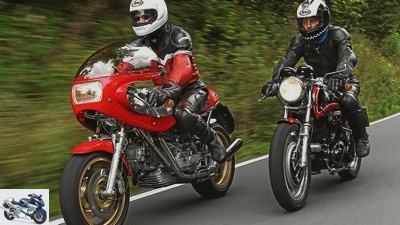
Jahn
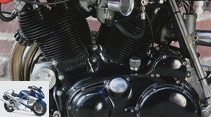
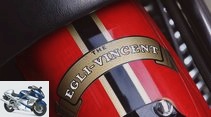
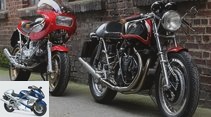
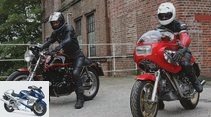
25th photos
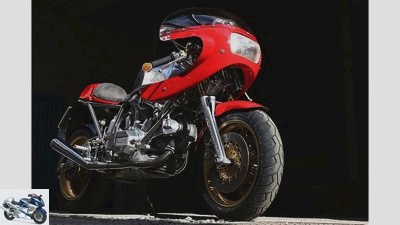
1/25
Egli-Ducati 960.
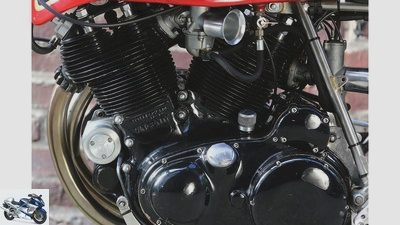
2/25
Double fleet: The layout of the cylinders and their heads on the V2 largely follows that of the Vincent single-cylinder.
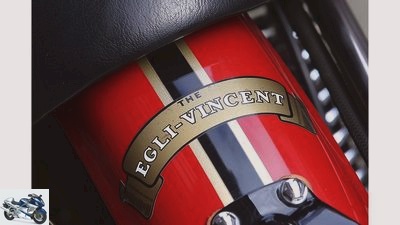
3/25
Roger Slater was only allowed to offer his early products under the renowned Egli label.
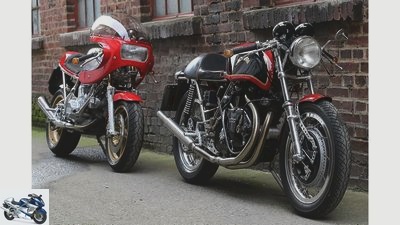
4/25
Egli-Ducati 960 and Egli-Vincent 1000.
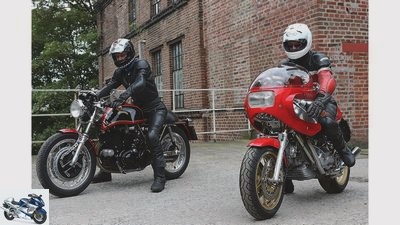
5/25
Egli-Ducati 960 and Egli-Vincent 1000.
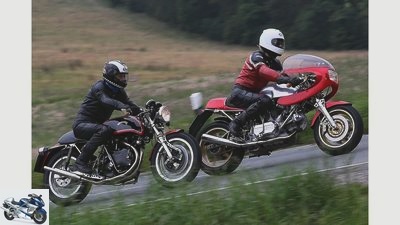
6/25
Egli-Ducati 960 and Egli-Vincent 1000.
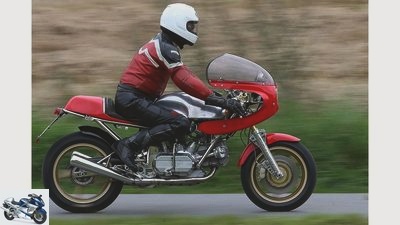
7/25
Egli-Ducati 960.
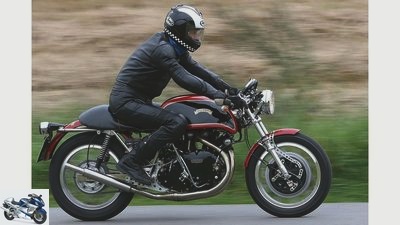
8/25
Egli-vincent 1000.
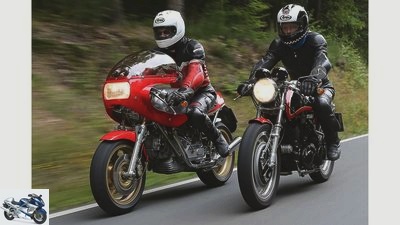
9/25
Egli-Ducati 960 and Egli-Vincent 1000.
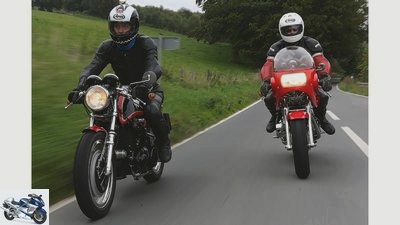
10/25
Egli-Ducati 960 and Egli-Vincent 1000.
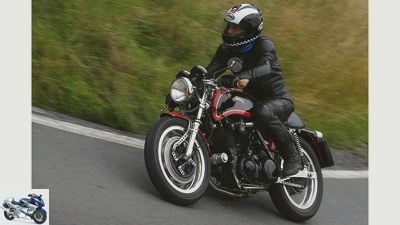
11/25
Egli-vincent 1000.
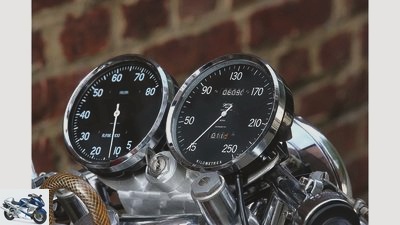
markus-jahn.com
12/25
The enormous Smith watches tower up between the handlebars taken from a Guzzi Le Mans I..
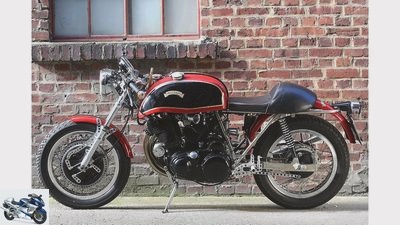
13/25
Egli-vincent 1000.
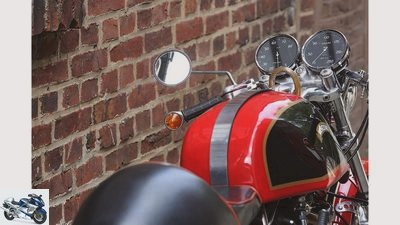
14/25
Fritz W. Egli liked the idea of a backbone frame that functions as an oil tank.
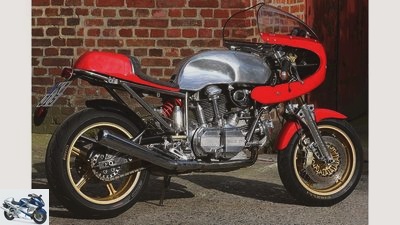
15/25
Egli-Ducati 960.

16/25
Egli-Ducati 960.
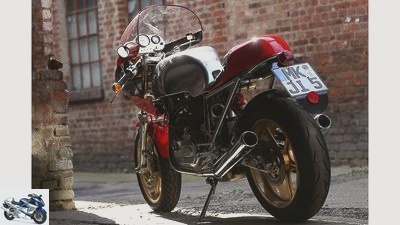
17/25
Egli-Ducati 960.
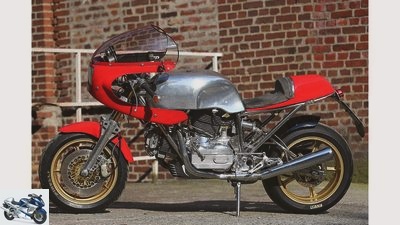
18/25
Egli-Ducati 960.
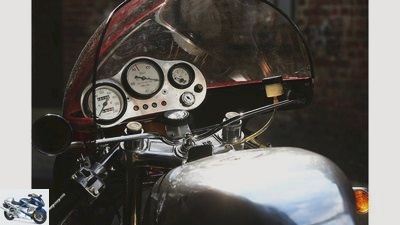
19/25
Veglia Competizione instruments determine the picture in the cup of the gossamer cladding, which is pulled far back.
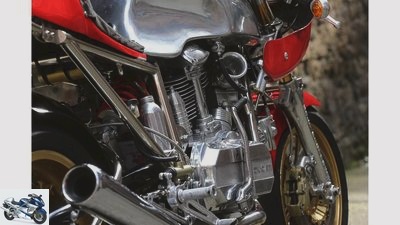
20/25
Egli-Ducati 960.
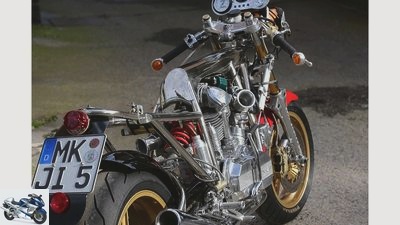
21/25
The minimalism and logic of the Egli frame are still impressive. A Ducati-V2 couldn’t live more beautifully.

22/25
Egli-Ducati 960.
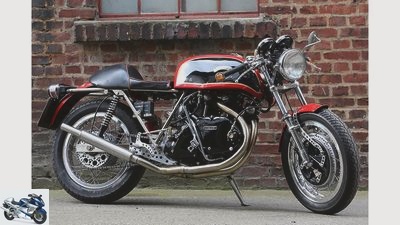
23/25
Egli-vincent 1000.
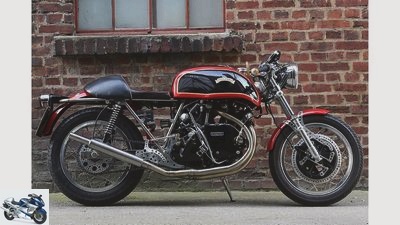
24/25
Egli-vincent 1000.
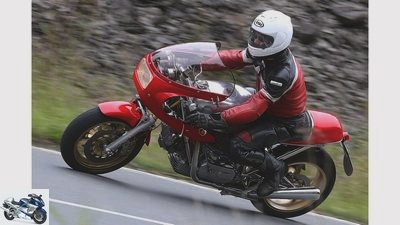
25/25
Egli-Ducati 960.
On the move with the Egli-Ducati 960 and Egli-Vincent 1000
The most beautiful motorcycles in the world?
Content of
Whenever the inventive Swiss comrade Fritz W. Egli put together his glittering pipe work for a Japanese four-in-a-row, a cult object emerged. But what if the engine came from Ducati, even from Vincent?
E.There are these motorcycles that leave no questions unanswered. Around which – regardless of where they are currently parking – there are always a few people standing around in silence, amazed, and looking at them leaves you feeling as tidy as walking through a Japanese garden. Everything about them has its right place, everything has its right size, meets in the intoxicating harmony of form and function.
Buy complete article
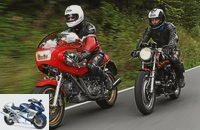
On the move with the Egli-Ducati 960 and Egli-Vincent 1000
The most beautiful motorcycles in the world?
Ducati 960 … Fritz W. Egli certainly also created some creations with single-cylinder or in-line engines that can evoke similar associations. With one, with the other, possibly with many. But not with all.
Is the V-twin cylinder the ideal?
With almost all of them, at least, and this fact indicates that a number of enthusiasts consider the two-cylinder V-engine with a transverse crankshaft to be the most suitable drive for a motorcycle: it has enough power, makes a difference and does not carry on. In the pioneering days, it also offered (cooling) technical advantages and was very widespread. Later, however, its cost disadvantages came to the fore, and so only a few brands remained loyal to it after the Second World War. The hottest device still wore V2: The Vincent Black Shadow with its 55 hp ran away from all other production motorcycles. Until 1955, then the manufacturer went bankrupt.
Ducati was only nearly broke when the 750 GT debuted in 1970. Your V2 is called L-Twin because it spreads its cylinders at an angle of 90 degrees and the lower one is almost horizontal. The vertical shaft drive of the one overhead camshaft promised sporty qualities, the actual output of around 50 hp was a bit disappointing. But then came Paul Smart and Imola: With the desmodromic upgraded valve train, the Ducati left everything behind in the 1972 200-mile race, Europe’s resistance to Japan’s multi-cylinder had a name: 750 SS. The creator of this miracle, Dottore Fabio Taglioni, prescribed Out of respect for the new performance horizons, his twins have the highest level of straight-line stability.
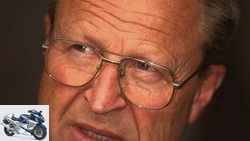
Sports & scene
What actually drives: Fritz W. Egli
20 questions to Fritz W. Egli
read more
Allow as little bending force as possible into the braid
This is exactly where Fritz W. Egli started shortly afterwards. The Swiss precision mechanic had built chassis for Vincent V2, Honda two- and four-cylinder, Triumph and Laverda twins as well as Kawasaki two-stroke engines by 1973, all of which were not only blessed with stability, but also with handling suitable for the Alps. Basically, he arranged his frame around a ten centimeter thick central tube made of high-strength precision steel, to which the steering head is attached at the front and two cantilevers at the rear, which are only subjected to tension and pressure, to accommodate the swing arm.
Let as little bending force as possible into the mesh, that is the motto, and use the highest possible quality components from the steering head bearings to the struts. In the first Ducati creation of the Swiss, the round motor is logically still in place, two spring struts support the Egli swing arm against the rear frame. The part is called phantoms, and the name says it all: the ten or so examples that were built almost never appear.
Camshafts come from the Australian Ducati tuner Vee Two
On the other hand, you can often see Michael Niemann’s magical and regularly moving motorcycle. He had had an Egli long ago, with a 750 Honda Four, when he was allowed to drive an Egli Ducati test machine freshly prepared for MOTORRAD with a 900 and suddenly fell in love. Something like that had to be found now, in the form of a kit and the used engine of a 900 SS from 1981. The same was then carefully revised and lovingly tightened. First of all, the bore grew from 86 to 90 millimeters, which increased the displacement from 864 to a tight 960 cm³. Mahle pistons rage up and down in the Nikasil cylinders, connected to the finely machined crankshaft via Carillo connecting rods. Camshafts from the Australian Ducati tuner Vee Two set the enlarged valves in motion, the channels have been machined.
That would outline the hidden strengths of this motorcycle. Its visible parts are actually self-explanatory. Egli Campagnolo magnesium wheels and the Swiss 38er racing fork with its distinctive stabilizer are mandatory. Of course – and again something hidden comes up again – Michael Niemann had their dip tubes coated on the inside with a Teflon-impregnated coating for better sliding properties and the stanchions with PVD titanium nitrite. He just wants to know, and he must also want to know: the qualified production technician operates Egli-Racing Germany in Iserlohn, looks after between 600 and 700 customers all over the world – and practiced at Fritz W. himself as part of his thesis. Michael is fascinated by how competitive such a perch can be kept to this day, and it is not just the mounted Brembo racing pliers or the Ohlins-inspired central spring strut that give his statement the necessary determination.
Swiss mountain champion in 1968 was called Fritz Walter Egli
The whole thing started with a similar approach: When the highly gifted precision mechanic Fritz W. Egli also wanted to test his talents as a racing driver, he turned to a ten-year-old Vincent and hoped to become Swiss mountain champion. That failed, but not because of a lack of talent or engine power, but because of the unsuitable chassis. As is well known, the ultra-modern 1000 series at the beginning of the 1950s already had a central tubular frame and a triangular swing arm, the front wheel was guided by a hydraulically damped parallelogram fork. Everything is quite neat in normal traffic, but not suitable for racing.
Egli liked the idea of the backbone frame that doubles as an oil tank, but a ten-centimeter-thick pipe would be much more torsion-resistant. Small retaining plates connected it to the engine. Triangular swing arm was okay too, but unfortunately there weren’t any suitable accessory struts back then. So he supported the self-made two-arm swing arm conventionally with two legs. A Ceriani fork guided the front wheel and off we went. After seven wins in eight races, the Swiss mountain champion in 1968 was called Fritz Walter Egli. In the following years, he left his racing machine to two friends, who were responsible for the championship until 1973.
An unpleasant, but no longer painful experience
Egli himself, however, had to appease the ghosts he called in 1967 when he presented his Egli-Vincent 1000 at the ZÜSPA trade fair in Zurich. He received inquiries for a frame or even a complete motorcycle from all over the world, and it soon became difficult to get hold of motors. His English importer Roger Slater, who had already been employed in 1968, was at the source and wanted to sell. So Egli allowed his frames to be built in England, which were then completed at Slater. Too bad that other people did their business with almost identical frames and so Slater got the idea of circumventing the license agreement with Egli and buying cheaper elsewhere, namely at Erik Cheeney. An unpleasant, but no longer painful experience for Fritz Egli.
The entire replica has rarely harmed the motorcycles, and that’s why Martin Stegemann didn’t have to think twice when he was able to purchase an Egli-Vincent 1000 with a Slater frame. His passion was sparked over 30 years ago by a book called “Feuerstuhle”, and the two Egli-Vincent depicted there followed him into his sleep. His longing was only fulfilled in 2006, when an outwardly quite decent specimen moved from London to the German lowlands. The frame was painted, not uncommon. Most of the time, however, the owners enjoyed the sheen of their nickel-plated tubes, and Stegemann wanted to do the same. So he carefully peeled off the red paint, leaving the actual paintwork parts such as the tank and fenders with their nice patina.
The Vincent V2 is a force
The engine, which had run down completely, required more work. This had left the Vincent plant in Stevenage near London in 1955, and quite completely hidden under the expansive disguise of a Black Prince. Not only this renowned brand saw its last chance in weather protection. Roger Slater didn’t care, as in the Black Shadow, the 50-degree twin makes a healthy 55 hp. Thanks to its camshafts, which have slid far up and are driven by means of gear wheels, quite short bumpers are sufficient, while the rocker arms that engage the valves in the middle reduce their overall length even further. The nominal speed of 5500 rpm is already quite high for a giant twin of the time, racing versions including the Black Lightning offered ex works put an additional 1,500 tours for their 70 to 80 hp. That made it critical. A triplex primary chain transfers the power to the four-speed transmission via a combined multi-disc drum clutch.
The first Vincent-V2 was built before the war and still had a cylinder angle of 47.5 degrees. Because of its many lines and connections, it was called plunger’s nightmare, the plumber’s nightmare. The post-war construction with a 50-degree angle should be tidier, but it doesn’t matter: Just like the great Fritz, Martin Stegemann is a trained precision mechanic and he prefers things to be really complicated. However, his motorcycle experience is based on years of BMW screws, and so he tackled the spur gear drive of the camshafts with German tolerances. After that, nothing worked at all. The battery ignition also wanted war and was constantly on strike. A pragmatic Vincent driver who Stegemann met on the Isle of Man and who advised electronic BTH ignition helped.
Bikes are some of the most beautiful motorcycles in the world
Stegemann took a strictly classic approach to the wheels and upgraded to narrow rims, at the front he spoked a rather rare – of course really complicated – eight-shoe brake from CMA. These parts go back to the racer Dave Degens, who used them successfully in his endurance triumph at the end of the 60s. As with the Duc by Michael Niemann with its brutal Brembo pliers, this mechanical marvel also corresponds to the spirit of an Egli: What is allowed is allowed. And Fritz, the federal free spirit, would certainly not have anything against the kick starter on Stegemann’s Egli-Vincent 1000. The wildly curved original stands in the way of relocated stops and is cheese anyway. So he had a new internal gear eroded into a Honda kicker.
He can now unfold it calmly. Two kicks, the mighty V2 is already running, rattles much less than expected. The L-Twin from Bologna also starts willingly on the first or second kick, sounds a little deeper than the Vincent from its revised Conti tailpipes and revs up audibly more spontaneously when warming up. The quiet observer steps back a meter and listens ecstatically: This special sound, enforced by an uneven firing sequence and enriched by open intake funnels, which turns from a rather rough idle speed into comfortably threatening bursts of strength. That was exactly what was missing to complete his judgment. No more questions, the Egli-Ducati 960 and the Egli-Vincent 1000 are among the most beautiful motorcycles in the world.
Technical data Egli-Ducati 960
markus-jahn.com
960 cm³ displacement and 90 hp performance at 8000 rpm: the Egli-Ducati 960.
Egli-Ducati 960
Engine: Air-cooled 90-degree two-cylinder V-engine, one overhead camshaft driven by a vertical shaft, two desmodromic valves per cylinder, Ø inlet 43 mm, Ø outlet 38 mm, machined channels, two Dellorto carburettors, Ø 41 mm, Bore x stroke 90 x 74.4 mm, compression approx. 10: 1, displacement 960 cm³, power 90 HP at 8000 rpm.
Power transmission: Multi-disc clutch in an oil bath, five-speed gearbox, secondary drive via chain.
Landing gear: Central tubular frame, Egli Racing telescopic fork front, Ø 38 mm, Egli triangular swing arm with central spring strut, frame and swing arm nickel-plated, Egli Campagnolo magnesium wheels, front tires 130/70 ZR 16, rear 180/55 ZR 17, double disc brakes with Brembo four-piston -Racing brake calipers at the front, Ø 300 mm, rear disc brake, Ø 230 mm, polished Egli aluminum tank.
Empty weight: 170 kg
Info: Michael Niemann, Egli-Racing-Deutschland, Obere Muhle 28, 58644 Iserlohn, Telephone: 0 23 71/2 52 92
Technical data Egli-Vincent 1000
markus-jahn.com
998 cm³ displacement and 55 hp at 5500 rpm: the Egli-Vincent 1000.
Egli-vincent 1000
Engine: Air-cooled 50-degree two-cylinder V-engine, one underlying camshaft, two valves per cylinder operated by rocker arms, bumpers and rocker arms, two Amal-TT carburettors, Ø 28.6 mm, bore x stroke 84 x 90 mm, Compression 8.5: 1, displacement 998 cm³, output 55 hp at 5500 rpm.
Power transmission: Primary drive via triplex chain, two-disc / drum servo clutch, four-speed gearbox, secondary drive via chain.
Landing gear: Central tubular frame, Ceriani GP fork, Ø 35 mm, two-arm swing arm with stereo suspension struts, nickel-plated frame and swing arm, spoked wheels with Akront high-shoulder aluminum rims, tires 100/90 x 18 at the front, 120/90 x 18 at the rear, eight-jaw CMA drum brake at the front, simplex drum brake at the rear, Slater aluminum tank.
Empty weight: 175 kg
Info: A wonderful English language website is dedicated exclusively to the diverse Egli-Vincent: www.egli-vincent.net. You can find out more about the Vincent brand at www.thevincent.com
Opinions of the owners
markus-jahn.com
The two bikes are owned by Michael Niemann (Egli-Ducati 960) and Martin Stegemann (Egli-Vincent 1000).
Michael Niemann, owner of the Egli-Ducati 960
The carbon parts available today for Egli motorcycles, the Egli fork with the different coating variants to reduce the breakaway torque and the adjustable damper systems, the fully adjustable shock absorber and much more were created when I built my Egli Ducati 960. The development of the Pirelli tires also took place contributed to perfect driving behavior. For me, this motorcycle is a dream on two wheels, perfection is reduced to the bare essentials. The vertical shaft motor with a lot of torque from the cellar, which pushes emphatically into the red area if necessary, a chassis that can handle everything, and the fantastic handiness are things that make you forget the real age of this construction. This perch is pure enjoyment.
Martin Stegemann, owner of the Egli-Vincent 1000
Two things made me buy: the exterior, dominated by the magnificent engine, and the interest in the mechanics of this not exactly simple engine. Hit. Like over 30 years ago, I find the Egli-Vincent 1000 adorable. What surprised me even more: I still really enjoy driving this handy, stable machine. But not in the dark because of the 6-volt system. Because I also use modern equipment, I know that there is even better, but I really don’t notice its old age on my motorcycle. The V-Twin develops a lot of steam even at low engine speeds; on normal country roads I actually only need the last two gears. On the other hand, he turns up quite willingly – it’s great what they did at Vincent over 60 years ago.
Related articles
-
On the move: Benelli 750 Sei, Honda CBX 1000, Kawasaki Z 1300
Bilski 17th photos Bilski 1/17 Who is the widest in the whole country? The angle of spread of the driver’s legs provide information. Bilski 2/17 With…
-
On the move with the Honda CB 900 F Bol d‘Or, Honda CBX, Kawasaki Z 1000 ST and Kawasaki Z 1300
Arturo Rivas 45 pictures Arturo Rivas 1/45 Six against four for first: Honda CBX and Honda CB 900 Bol d’Or. Arturo Rivas 2/45 Honda CBX. Arturo Rivas 3/45 …
-
On the move with a Kawasaki Z 1000 and Zephyr 1100
www.bilski-fotografie.de 36 pictures www.bilski-fotografie.de 1/36 Genetically not related, but they belong to the same family: Kawasaki Z 1000 and …
-
On the move: Walter-Suzuki GT 1000
fact On the move: Walter-Suzuki GT 1000 The really big thing Contents of If already, because already, Walter Friedrichs said to himself as he started to …
-
On the move: Honda VF 1000 R, Kawasaki GP Z 900 R, Suzuki GSX-R 1100
Jahn On the move: Honda VF 1000 R, Kawasaki GP Z 900 R, Suzuki GSX-R 1100 Technical revolution Content of They drove us crazy – and saved us money:…
-
On the move with the Kawasaki Z 1000 R.
Wolf 25 pictures Wolf 1/25 Urahn: The roller bearing mounted R-motor is still based on the 900 of the Z1. Bore: once 66, now 69.4 mm. Wolf 2/25 The …
-
On the move: return of the Wankel Van Veen OCR 1000
Melkebeek On the move: Van Veen OCR 1000 Return of the Wankel engine by Van Veen Contents of motorcycles with Wankel engines were not a great success …
-
On the move with the Honda GL 1000 Gold Wing
Jahn 11 pictures Jahn 1/11 In view of the enlightening driving impressions with the Honda Gold Wing from 1977, many old prejudices have to be straightened out ….
-
Presentation of the Honda VTR 1000
Presentation, Honda VTR 1000 F Firestorm Honda VTR 1000 Italy’s sport twins were the sole rulers. Forza Italia. Now the world power Honda is striking back, …
-
Archive cult bike Egli-Ducati 900 SS cult meets cult Fritz W. Eglis is undoubtedly one of the most exquisite storage places for a V2 vertical shaft …